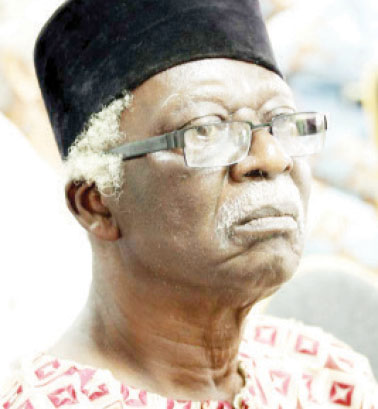Bruce Onobrakpeya, one of Nigeria’s most respected and prolific artists, has had yet another impressive outing at the National Museum of African Art, Washington DC.
The event, which took place on Saturday afternoon, July 16, had art enthusiasts and the general public meet the artist between 1pm and 4pm in the garden-level Pavilion.
One of his portfolios of prints is in the “Artists’ Books and Africa” exhibition at the Museum (Level 3). The Saturday exhibition presented the complete set of prints in the Pavilion, where the artist engaged with visitors about his works.
Born August 30, 1932 in Agbarha-Otor in present-day Delta State, Onobrakpeya is a Nigerian printmaker, painter and sculptor. He has exhibited at the Tate Modern in London, the National Museum of African Art of the Smithsonian Institution in Washington D.C. and the Malmo Konsthall in Malmo, Sweden. The National Gallery of Modern Art, Lagos has an exhibit of colourful abstract canvases by the artist.
The son of an Urhobo carver, Onobrakpeya Obi Omonedo, he was raised as a Christian, but also learned the traditional beliefs. His family moved to Benin City in the present Edo State when he was a child. He attended Western Boys High School, where he was taught art by Edward Ivehivboje, among other subjects.
He also attended drawing classes at the British Council Art Club in Benin City. Inspired by the water colour paintings of Emmanuel Erabor, after leaving high school, he was hired as an art teacher at the Western Boys High School (1953–1956). In 1956, he left for Ondo, where he taught at the Ondo Boys High School for a year.
In October 1957, Onobrakpeya was admitted to the Nigerian College of Arts, Science and Technology, now the Ahmadu Bello University (ABU), Zaria.
Funded by a Federal Government Scholarship, Onobrakpeya was trained in the Western tradition of representational art. At the same time, he began to experiment with forms in relation to Nigerian folklore, myths and legends. Much of his work uses stylistic elements and compositions derived from traditional African sculpture and decorative arts.

- Advertisement -
- Advertisement -
Must Read
BREAKING: 19 killed as Dangote truck rams into bus in Kogi
19 killed as Dangote truck rams into bus in Kogi
By Jeffrey Agbo
No fewer than...












